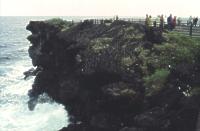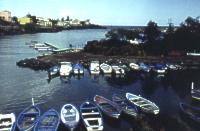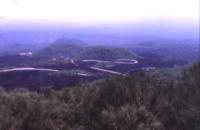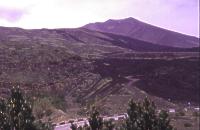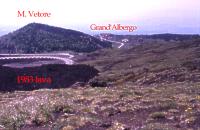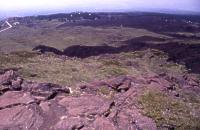| Etna
index |
||
| Geology | Geological history | Cones and craters |
| Eruptive characteristics | Eruptions before 1971 | Eruptions since 1971 |
| Etna and Man | References | Web sites |
| Weather forecasts | FAQ | Latest news |
Etna
dominates the everyday life of the Sicilians, especially in the eastern
part of the island,
and this is reflected in this small selection of Sicilian products like
coffee, pasta and water.
This is evidence of admiration and respect rather than fear.
Etna and Man
Since the dawn of humanity, Sicily's great volcano has inspired the culture and religion of all people who have lived in its shadow. It has given one of the most fertile areas to the Mediterranean, but with its frequent eruptions it has often threatened human settlements, buried cultivated areas, and destroyed homes. The relationship of the people to their mountain is understandably complex. Here some aspects of human life and activity on the slopes of an unusually active and large volcano will be discussed, such as the feelings the people in eastern Sicily have for "a' muntagna" (the mountain), a chronology of Etna's fiery assaults on inhabited and cultivated areas, and attempts to protect inhabited areas from invasion by lava flows. While these pages are yet to be written, you may read a bit about this subject in some chapters of the Etna FAQ.
"SCASSAU A MUNTAGNA!"
Every few years, these words cried by the inhabitants of the villages on the slopes of Etna, signalled the initiation of a new eruption that apparently threatened their homes and land. Apart from being a fine example of Sicilian dialect (the rough translation is "the mountain has broken"), this expression reflects one of the rare instants in the life of a Sicilian living on the flanks of the volcan when the usual indifference changes abruptly into excitement and apprehension.
The chance, in a lifetime of a person living near Etna, to see her or his home invaded by lava is very low. Although everybody here has seen the volcano erupt many times, the normal rhythm of life is rarely affected by these activities, and the most serious encounter with the volcano is comonly limited to a fall of ash or small scoriae.
Contrary to common belief outside the Etna region, life close to the volcano is essentially peaceful and pleasant, for the area enjoys a particularly favorable climate, extremely fertile soils, and a spectacular scenery. Catania, the largest city near the mountain, is vigorously recovering from years of mafia-related violence and decadence, and its most acute problems are of social rather than volcanic origin.
Since Millennia Man is attracted by Etna, and at the same time the news of its activity has the taste of a remote, mysterious terror, especially to those living far from Sicily. Even though many people, among them a good proportion of the visitors to this site, have only vague ideas about the location of the volcano relative to towns and other places in and around Sicily, there is a remarkable worldwide interest in the volcano.
What is it that makes Etna the subject of such intense interest? Why are there so many people living on this volcano? And how true are the notions of frequent disasters caused by its eruptions, and of the threat of future eruptions?
I describe here the way in which human life is influenced by, and interacts with, the presence and volcanic activity of Etna, how the local population feels about the mountain, and why Etna enjoys such a great fame all over the globe. This will to some degree be interwoven with my own experience in the past 15 years, assembled during many visits to the area, and - since early 1997 - during my residence in Catania. This sections includes a detailed analysis of true and alleged cases of human deaths caused by eruptions of Etna throughout history and of the amount of damage and destruction caused by eruptions since 1600. Many readers will be surprised how much of the fame of Etna as a killer volcano greedy of devouring villages and cities is remote from the truth. Yet the last part of this section (about volcanic hazards) demonstrates that in spite of its relatively benign behavior in recent centuries, Etna is a volcano capable of really evil things of cataclysmic dimensions, the worst of which, however, occur extremely rarely and are unlikely to be experienced by anyone living on the slopes of the mountain today.
THE FAME OF A UNIQUE VOLCANO
Since the dawn of the ancient Mediterranean cultures, the volcano and its ceaseless activity have deeply impressed the humans who lived to see it, and spread the news of this fire-breathing giant far beyond the shores of Sicily. But it was not only its destructive and terrifying potential that rendered it famous, the ancient descriptions also vastly enlarge upon the charming character of the Etnean landscapes and the exceptional fertility of its soils. Certainly the paintings of horrors and cataclysms were more persistent in the historic records, even though these do not represent the ultimate truth. Among the factors contributing to this strong emphasis on the negative side there were the earthquakes that repeatedly ravaged the eastern coast of Sicily and adjacent areas. These events which had far more devastating effects than Etna's eruptions, have often been wrongly attributed to the volcano, although it is now known that most of the regional seismicity is only remotely related to the volcanic activity.
Due to this mixing of the effects of earthquakes and eruptions, an image of a fierceful, deadly volcano has emerged, guilty of tens of thousands of victims and repeated destruction of towns and villages and of vast stretches of fertile land. Two major disasters are generally cited in general geology texts (and in the touristic literature): one in 1169, reponsible of up to 15,000 deaths, and another in 1669 which is said to have killed up to 20,000 people. Etna thus would have produced more victims than Vesuvio (Vesuvius) , a highly explosive and much more densely populated volcano near the city of Napoli (Naples). In both the 1169 and 1669 events, however, no victims were produced by eruptions. In the former case it is not even sure if there was any eruption during that year. The 1169 deaths almost certainly resulted from a tectonic earthquake (Magnitude 7) originating from the Malta Escarpment, a seismically active fault zone extending from Etna to the southeast. The 1669 eruption on the other hand did actually take place and was destructive indeed. Some 15 villages, including Nicolosi, were buried under the lava (see a map of the 1669 lava flow), and Catania was seriously endangered by the lava which broke through the city walls in two places. There is nevertheless no reason to assume that anybody was killed by the lava flow that arrived at Catania only one month after the beginning of the eruption. While contemporary sources (eyewitness accounts) do not mention any fatalities, it appears that the overwhelming death-toll of the violent (Magnitude 7.3) earthquake that devastated all of eastern Sicily only 24 years after the eruption somehow found its way into reporting on the 1669 eruption in secondary sources. A much more recent misinformation of the same type attributes 5 deaths to the 1928 eruption of Etna, and one has to refer to the primary sources describing that event to see that in fact it did not produce any fatalities.
It is for these and other dramatized descriptions of Etna and its eruptions that each time there is some activity there is a high public interest, especially in regions and countries other than Sicily. Having in mind the vision of a killer volcano, tourists (especially American citizens) ponder whether to cancel their forthcoming holidays in Sicily once the mass media report that Etna is in activity. Reporters and television crews flock at the mountain, hoping to be there when the "Big Bang" occurs. This attitude reached absurd proportions during the eruption of July-August 2001 and was manifest in vastly exaggerated reporting on the event in the mass media. Many wonder why there are people living near an active volcano with such a devastating potential. As a particular feature I have received in the past few years many questions from Americans who were worrying about their relatives stationed at the military air base of Sigonella, some 15 km south of Catania.
There is, however, a good proportion of people who have a more realistic idea of Etna and visit the volcano to enjoy the spectacle of its eruptions and its scenic beauty. The possibility to see flowing lava and ejections of incandescent pyroclastics at fairly close range in a highly accessible place attracts the curiosity of many visitors. For this same reason any period of prolonged summit activity provokes a massive touristic response, such as during the eventful years of 1995-2001. At the time of writing (spring 2002) Etna is showing signs of returning to its spectacular but relatively harmless summit activity, which will give tourism in Sicily a boost after the negative impact of the 2001 eruption and of the barbarian terrorist attacks of 11 September 2001.
Apart from the aforementioned exaggerations and false informations, Etna continues to be veiled in mystery and fascination even at the beginning of the third millennium, and I believe that this is fully justified. To a geologist living near this volcano, who has been in the summit area more than 110 times in 5 years, the principal attraction is to see the constant changes that occur up there, the appearance and growth of cones, the filling and subsidence of craters, the resurfacing of certain areas by lava flows and pyroclastic deposits, and the dynamics that determine the shift from summit to flank eruptions. The fame that Etna enjoys among volcanologists is that of an unusually versatile, highly active and complex volcano, located in a tectonic setting that appears to be among the most puzzling in the world. It is well-studied and its activity is documented over an exceptionally long period, and yet working on Etna is a challenge for it is so densely populated and has vast areas of high agricultural and other economic value. Even though Etna is anything but a killer volcano, it has a high destructive potential.
PAGE
TWO:
A CHRONOLOGY OF ENCOUNTERS BETWEEN MAN AND ETNA
Copyright © Boris Behncke, "Italy's Volcanoes: The Cradle of Volcanology"


